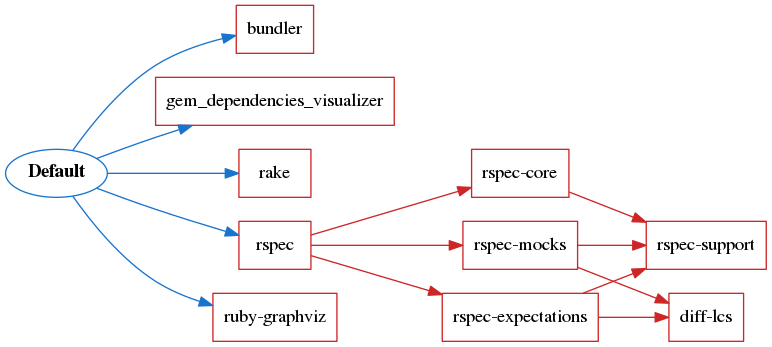
Security News
38% of CISOs Fear They’re Not Moving Fast Enough on AI
CISOs are racing to adopt AI for cybersecurity, but hurdles in budgets and governance may leave some falling behind in the fight against cyber threats.
gem_dependencies_visualizer
Advanced tools
Add this line to your application's Gemfile:
gem 'gem_dependencies_visualizer'
And then execute:
$ bundle
Or install it yourself as:
$ gem install gem_dependencies_visualizer
To produce a graph of your gem dependencies, pass the content of a Gemfile.lock and, if available, the content of the Gemfile as is as an input to the visualizer. For gems, you can also use a different method to pass the gemspec and your Gemfile.lock content. You can (optionaly) pass a graph name you might want to give to the .png file to be produced.
To use it just run the following in your code:
GemDependenciesVisualizer.produce_gems_graph(gemfile_content, gemfile_lock_content, graph_name, options = {})
GemDependenciesVisualizer.produce_gems_graph_from_gemspec(gemspec_file_content, gemfile_lock_content, graph_name, options = {})
Available options you could use are:
For example by using the produced Gemfile.lock in this gem, we can get the following:

After checking out the repo, run bin/setup to install dependencies. Then, run rake spec to run the tests. You can also run bin/console for an interactive prompt that will allow you to experiment.
To install this gem onto your local machine, run bundle exec rake install. To release a new version, update the version number in version.rb, and then run bundle exec rake release, which will create a git tag for the version, push git commits and tags, and push the .gem file to rubygems.org.
Bug reports and pull requests are welcome on GitHub at https://github.com/arcanoid/gem_dependencies_visualizer. This project is intended to be a safe, welcoming space for collaboration, and contributors are expected to adhere to the Contributor Covenant code of conduct.
The gem is available as open source under the terms of the MIT License.
FAQs
Unknown package
We found that gem_dependencies_visualizer demonstrated a not healthy version release cadence and project activity because the last version was released a year ago. It has 1 open source maintainer collaborating on the project.
Did you know?

Socket for GitHub automatically highlights issues in each pull request and monitors the health of all your open source dependencies. Discover the contents of your packages and block harmful activity before you install or update your dependencies.

Security News
CISOs are racing to adopt AI for cybersecurity, but hurdles in budgets and governance may leave some falling behind in the fight against cyber threats.

Research
Security News
Socket researchers uncovered a backdoored typosquat of BoltDB in the Go ecosystem, exploiting Go Module Proxy caching to persist undetected for years.

Security News
Company News
Socket is joining TC54 to help develop standards for software supply chain security, contributing to the evolution of SBOMs, CycloneDX, and Package URL specifications.